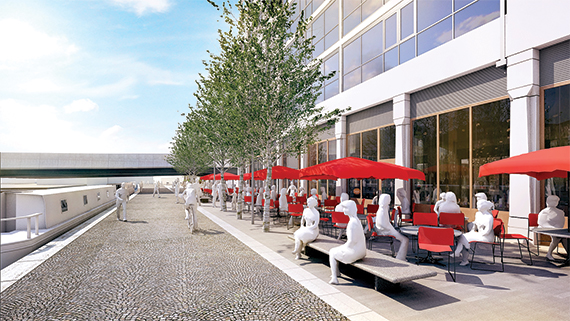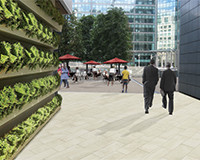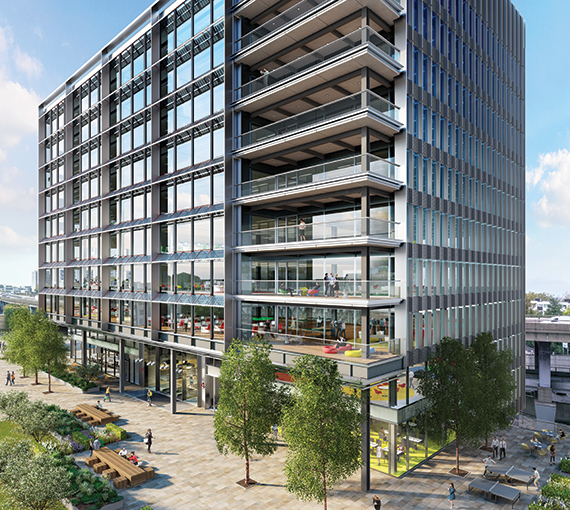For years, Paddington has been battling a serious image problem. When one of London’s major transport hubs is better known as the namesake of a certain marmalade-loving, Peruvian bear than for its infrastructure prowess, you know there is a long way to go.
But that has not stopped one of London’s best-known developers from taking a multi-million pound punt on one of the capital’s forgotten districts.
British Land’s off-market purchase of a £470m clutch of canalside buildings and sites from Aviva in 2013 was one of the biggest votes of confidence in the west London market since the Heathrow Express opened in 1998.
Cementing the move by fighting off overseas competition with the £210m purchase of Visa Europe’s headquarters at 1 Sheldon Square, W2, in April, the company has set a new yield benchmark for the area and taken control of Paddington Central’s gateway.
But despite an ambitious masterplan and the anticipated impact of Crossrail, Paddington as an area still trails behind Michael Bond’s fictional bear when it comes to winning over hearts and minds.
So what does British Land see that others have missed?
Image issues
Put simply, Paddington presented an opportunity to recycle capital from the £472m sale of Ropemaker Place, EC2, and bag 350,000 sq ft of development land in a market British Land believed was punching below its weight.
As for the image problem, British Land’s head of West End offices, David Lockyer, argues it is nothing insurmountable. In fact, he points out it is not dissimilar to the problems experienced in Regent’s Place, NW1, before British Land completed its 1.6m sq ft project there. It now boasts 99.4% occupancy, including a flagship letting to Facebook.
“We spent a lot of time on branding, public realm and perception there,” says Lockyer. Once one of the poorest areas in central London, marooned between Euston and Great Portland Street, Regent’s Place now boasts a thriving 13-acre mixed-use campus with a number of high-quality banking, professional services and technology occupiers.

As of 2014 it also represented an asset valued at more than £1.2bn.
The Paddington sub-market has not always delivered show-stopping returns. It underperformed in relation to the London average of 22.2% in 2014, with returns of just 16.2%. But the area is forecast for rental growth of 10.5% this year, above London’s 7.8% average, according to a report by Levy Real Estate.
Buoyed by flagship tenants such as Microsoft, and with the bulk of excess space that had put a drag on rents in the area now absorbed, the REIT thinks the time is right to give its estate – and by proxy the surrounding area – the makeover that will show everyone else they were right to take their Paddington punt.
Rental rises
If its valuers are to be believed, there is already plenty of proof that it was a good call. The estate is valued at £600m as of March this year – prior to the Visa purchase – according to the REIT. An uplift of £130m in two years.
DTZ head of investment Fergus Keane says: “Lots of people are negative about Paddington, where there hasn’t been huge rental growth in recent years and there are some quite sterile, corporate estates. But it has huge prospects – it is very cheap compared with other West End villages, especially if you need large floorplates.
“After the Heathrow Express completed, rents were at their highest correlation with Mayfair and St James – around 63%. If Crossrail has the same effect that same proportion means rents would stand at £80 per sq ft,” he adds.
Compare that with the current sub-£50 per sq ft rents on the estate, and Paddington starts to look like a tempting prospect. And the market’s changing perspective of the area is evident in the prices British Land had to pay for its holdings – a 6.2% yield for the 2013 purchase, compared with a 4.5% yield for 1 Sheldon Square – though this includes a rent review in 2017.
The first phase of public realm works has already begun, reworking the canal frontage. A new Hammersmith & City line entrance is to be the main conduit for commuters, with new greenery and an adjacent development by Derwent London expected to change the character of the route.

Meanwhile, British Land is staging events and summer film and sport screenings in the central Sheldon Square amphitheatre, representing its contribution to the collective project of changing the area’s appeal in tandem with rival developers Derwent, Land Securities and Sellar Property Group.
“When the estate is complete, it comes together as a compelling, attractive location,” says Lockyer.
Crossrail is coming
The impact of Crossrail on the sub-sector is hotly debated – will the 2018 rail link bring Paddington closer to the West End, or negate the need for travellers to stop there at all?
Since 2008, property prices near the station have outperformed the local market by 23.7%, according to Knight Frank, though this represents something of a markdown compared with Farringdon (24.4%) and Bond Street (38.4%).
While British Land is keen to acquire in markets like Farringdon, the chances of ever acquiring a 1m sq ft estate there are non-existent.
Instead, the hope is that Crossrail will broaden the appeal of Paddington to non-traditional occupiers. And traditional is anathema to British Land at the moment, after a decade-long drive to diversify away from finance and banking-dominated offices.
Tim Roberts, the group’s head of offices, says: “Our fortune was closely linked to one sub-sector in London, and quite a volatile sector. Now about 65% of our occupier base is non-finance or banking orientated.”
Faced with the question of exactly what profile of occupier wants to be in Paddington, Roberts says: “You could spend all your life trying to crystal ball gaze to see which sector is going to grow the most. None of us know. We want to produce great space that can appeal to most people.”
The opportunity to produce new space was a key draw to the Paddington estate. The speculative 145,000 sq ft 4 Kingdom Street, W2, started just before Christmas. It has a 2017 completion date and will take the holding to nearly 1m sq ft. Meanwhile, British Land is reworking the 210,000 sq ft consented plans for 5 Kingdom Street to bring a significantly larger building to the site, with an application planned in 2016.
British Land is in no mood to share Paddington Central, through joint venture or sale. In fact, it has opposite ambitions, refusing to rule out further purchases in the area. One obvious target is the Swedish firm Cityhold’s 1 Kingdom Street – the only building on the estate British Land does not now own.
A strategic play
Paddington is also a key tenet of British Land’s wider strategy, with the firm taking a markedly more bullish stance towards its £6.3bn London portfolio than its great rival, LandSec.
In its latest results British Land estimated rental growth of 8% across its portfolio, and the firm expects a low supply pipeline across London for 2015 and 2016 to continue to keep vacancy rates low.
Roberts says: “There is no sense that the market is going to get out of kilter. Just by investing in the West End and allowing the market to do what markets do, you will make a healthy return.”
Lockyer adds: “We see Paddington as a part of the West End – which at the moment isn’t fully recognised – as well as an area that is going to see infrastructure improvement.”
With the resources and willpower British Land and other developers are pumping into the area, Paddington Bear can expect to hardly recognise his namesake in five years’ time.
chris.berkin@estatesgazette.com












